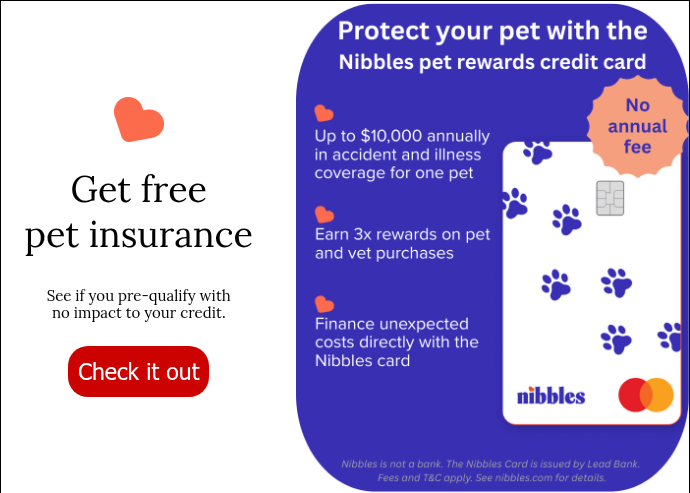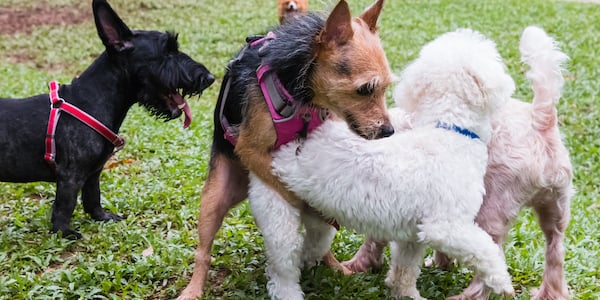 There's nothing quite like a dog humping that makes people go, "Eww, stop!"
There's nothing quite like a dog humping that makes people go, "Eww, stop!"
We may get embarrassed if our dog mounts another while visiting the dog park. And other dog owners may get rather perturbed if your dog keeps trying to hump theirs.
But humping in dogs is usually not related to any ... ahem ... sexual endeavors.
It's not only male dogs that hump either. Female dogs can exhibit mounting or humping behavior.
My spayed senior female Corgi will sometimes start humping my two-year-old male after a play session — if he gives her the chance. And on the flip side, even before being neutered, he never tried to hump my female dog.
Humping isn't just dog-on-dog either. Some dogs will cling to a person's leg and start humping or decide to grab a pillow for the job.
So why does this happen? Is humping something you should worry about with your dog? And how do you get your dog to stop humping? Read on for the answers!
Table of Contents
Why Dogs Hump
Humping is a natural and normal dog behavior that happens for a variety of reasons. Dogs of any age may initiate humping behavior, whether with their littermates, other pets in their home, or unknown dogs they meet at the park or at daycare.
Response to Stress or Overstimulation
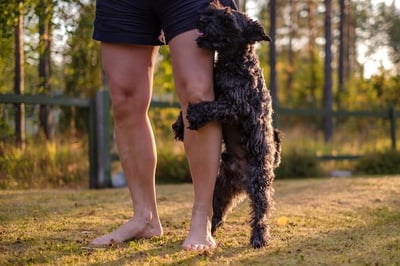
Humping can be a self-soothing behavior for dogs who are stressed, whether it's "good" stress or bad stress.
This is usually the most common reason for humping that I see in my behavior consultations.
Or a dog may become anxious in certain environments or when uncomfortable with what's going on around them, such as with other dogs or when new people visit your home.
When there's a lot going on in the environment, a dog may become overstimulated and not know how to deal.
A dog can start humping when they get really excited, such as when you arrive home after they've been alone all day or when guests come over to visit. This could happen when they are at a dog park or dog daycare, and there are a lot of different dogs and play styles that your dog can't control.
Play Initiation
Humping is a normal part of dog play behavior. It's not unusual to see a dog try to initiate play with another by humping or to see humping as part of wrestling. While it may be embarrassing to see your dog start to hump another, if it's just a short burst during otherwise appropriate play sessions, it's okay to let it go.
However, watch for other signs of stress or overstimulation, as a dog may start humping during play when they feel overwhelmed or are policing other dogs' play.
You'll also want to make sure that the dog being humped isn't showing signs of stress or dislike of being the target.
Some dogs don't mind it if it's just a small part of the overall play, but other dogs can get very annoyed and lash out in response. Learn more about managing dog play here.
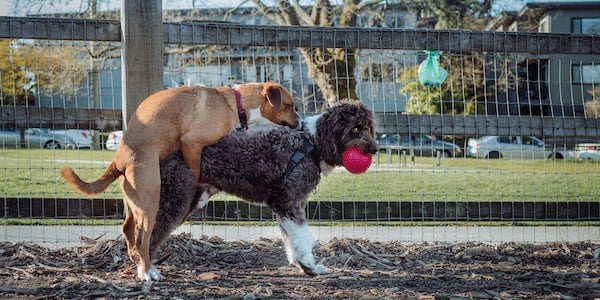
Dominance
I always hesitate to introduce the "dirty D word" when talking about dog behavior because it has been misused and misunderstood. And that misunderstanding of dominance has resulted in inhumane training methods being encouraged throughout the industry.
With that being said, humping can be related to dominance or social status in dogs.
BUT — the dog doing the humping isn't always the one trying to dominate the other.
A more insecure dog may hump a more confident dog simply because they don't have the social skills to otherwise deal with the situation. And a confident dog may just let them!
Typically, humping related to social status between dogs is seen along with other body language signals related to social status, such as posturing, submissive rollovers, or face licking.
If a dog is humping a person, it's most likely to be stress-induced or overstimulation.
Dominance between humans and dogs is rarely an actual thing.
Humans are what we call "super dominant" over dogs — we control all the resources, after all — and dogs know this.
Hormones
Yes, humping can be about sex! Puppies approaching sexual maturity (around 5–8 months old) may start humping for reasons other than play or stress. Those teenage hormones are raging, and it's instinctual to mount and hump in response.
Dogs can smell when a female dog is about to go into heat, and this can trigger the instinctual response to mount — even in neutered males.
A dog may also find out that humping feels good and then engage in more humping, whether on another dog, a person, or a favorite pillow, to experience this "pleasure" even more.
Watch this quick video to see a young puppy engage in humping with an adult dog playmate.
He's likely starting to feel the urge as he gets closer to sexual maturity, but it's likely combined with the excitement and overstimulation after romping around and playing.
Notice how the adult dog is rather permissive but does mouth at him to ask him to stop and then moves away. That's a great sign of a confident and well-socialized dog who knows how to interact with puppies well.
Here's another video example of a dog in a daycare setting who was five months old. His increase in humping was most likely caused by hormones, but could also have been a learned play behavior combined with overstimulation.
His humping became an issue because it was so obsessive — and he was a large and strong dog — he was dismissed from daycare a month prior to the neutering age requirement.
Note: You'll notice that the dog he is humping is rather permissive and doesn't seem bothered by being humped. The daycare attendants in this video allowed the humping to continue as long as it did, so they could get video footage to show the dog's owner.
Medical Issues That Can Cause Humping
Medical issues aren't the usual cause of humping in dogs. However, there are a few possibilities to consider and rule out just to be sure:
- Urinary tract infections: These are generally painful and may cause pain and swelling of the genitals. Humping may help relieve this discomfort.
- Skin infections: These types of infections are often itchy and cause irritation. Humping may be an alternative to chewing or licking to relieve discomfort, pain, and frustration.
- Priapism (persistent erection): When erections last for an extended period of time, it can be painful, and instead of licking, some dogs hump to ease the pain.
How to Stop Dog Humping
Humping, while a natural behavior, can become a problem for the following reasons:
- The other dog or pet may not tolerate humping and react aggressively to make your dog stop.
- A large dog can hurt a smaller or older dog in their enthusiastic humping efforts.
- Frequent humping, especially when young, can become a lifelong habit if not stopped.
- If caused by stress, a dog can become more fearful and anxious over time if not addressed. Humping may escalate to more reactive behaviors. Chronic stress affects your dog's health as well. It can lead to high blood pressure and other medical issues.
- "Intense" humpers are at risk of a ruptured spinal disc, especially in long-backed dogs like Dachshunds and Corgis.
- Most people don't appreciate being humped by a dog (and the larger the dog, the more likely they may knock over or injure someone). Young children, the elderly, or immunocompromised individuals are at higher risk of infection if accidentally scratched while being humped by a dog.
- Even if the humping is mostly a non-issue (such as play-related humping), other dog owners may not like or want your dog humping their dog.
Does Neutering Your Dog Stop Humping Behavior?
Having your male dog neutered can certainly help reduce hormone-related humping. However, it's important to address your dog's humping behavior prior to neutering if it is driven by hormones.
Not because it's not "okay" — remember, it's a natural and instinctual behavior. But hormone-driven behaviors can become lifetime habits even after neutering.
If a dog rehearses humping behavior over and over, it becomes self-reinforcing and will not just disappear after being neutered.

Address Your Dog's Stress
It's important to consider the environmental factors that may be causing your dog stress or simply being too much for them to handle all at once.
If these situations trigger humping behavior, you'll want to address whether taking your dog to the dog park or daycare is appropriate. Instead, you could set up playdates with other dogs that your dog is more comfortable with or plan your visits to the park when there are fewer dogs.
This can be especially helpful for dogs who hump as a way of policing other dogs' play.
If they hump people or other pets, you can reduce excitement and stress through management and training — keeping your dog in a separate area until they've calmed down (or for the entirety of the visit if the stress is fear-based), and working on desensitization and counterconditioning with a certified dog trainer or behavior consultant.
Providing other self-soothing activities for hyper or anxious dogs can go a long way in preventing the humping from even starting.
Interrupt and Redirect Your Dog
To stop humping, try to be proactive in managing your dog.
If I see a dog that is starting to mount or hump, I'll simply use their name recognition cue to interrupt and get their attention. Then I can redirect their attention to a different activity if necessary. I may allow them to go back to play, or I may have them take a break for a few minutes to calm down.
If your dog doesn't respond to their name or call away cue, then you need to go and get them. Give them a break for a few minutes before letting them go back to play. If they resume persistent humping, they are likely humping due to overstimulation, stress, or hormones. In this case, group play may not be a good choice for them while you work on addressing those issues.
Here's an example of me calling a dog during play who was starting to hump a playmate:
Provide an Alternative 'Target'
If your dog has taken to stress humping on pillows or other household items, or even humping people, sometimes the easiest solution is to give them a designated humping pillow or stuffed animal.
This could be something you do as a stopgap while you address their underlying stress or overstimulation, or can even be a long-term management solution for some dogs.
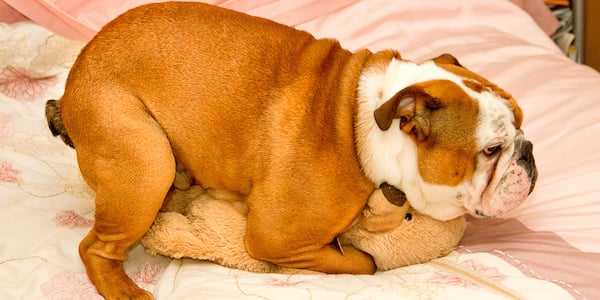
Don't Punish Your Dog for Humping
Humping is a natural dog behavior and can be a sign your dog needs support if they are overwhelmed or stressed.
Yelling at or otherwise punishing a dog for humping not only won't fix the problem, but it can have some unintended consequences, such as increased anxiety, damage to your relationship, or escalation into aggressive behavior.
Focus on calmly interrupting your dog's humping and then addressing the real reason they are engaging in this behavior.
Does your dog hump a lot? What do you think causes your dog's humping? Let me know in the comments!


